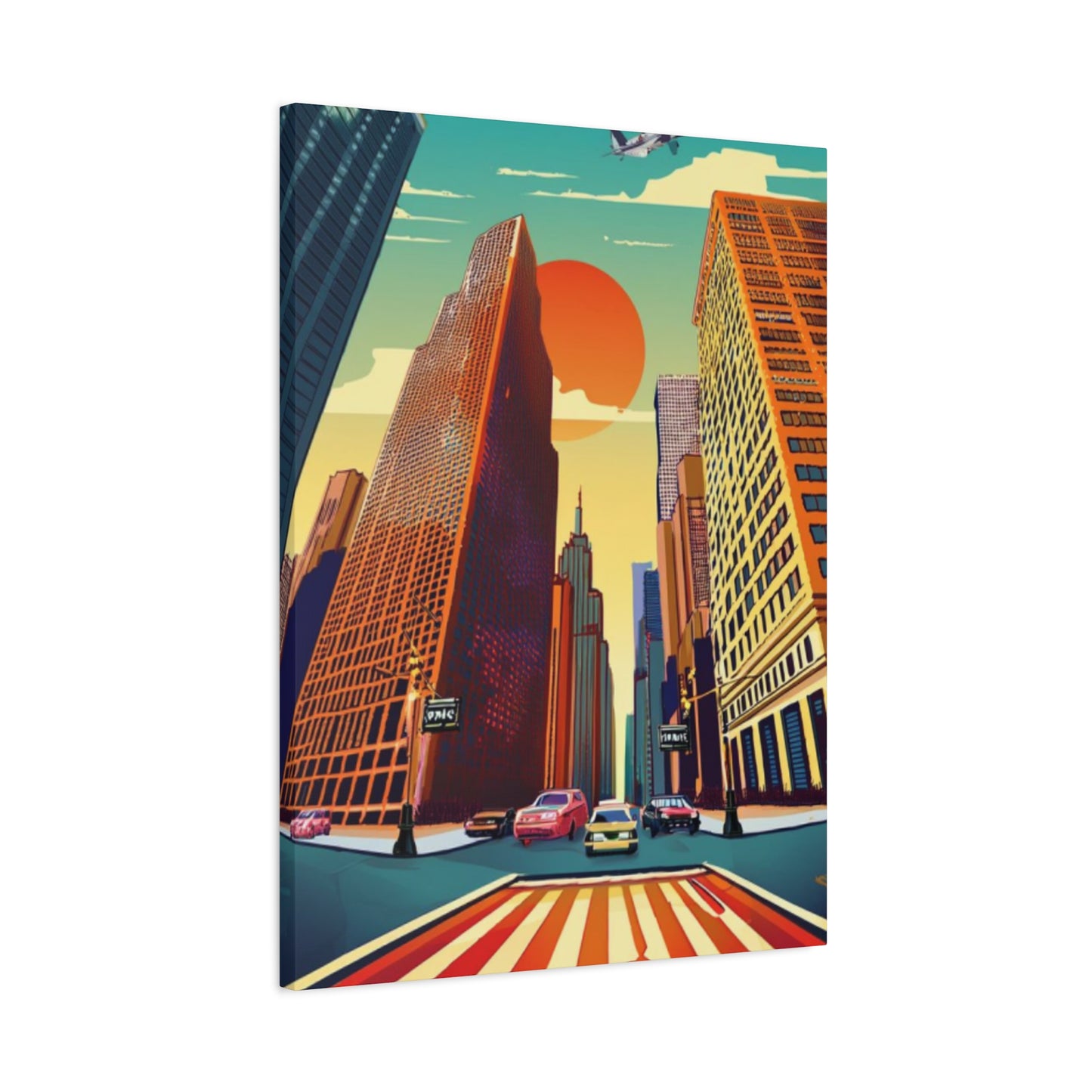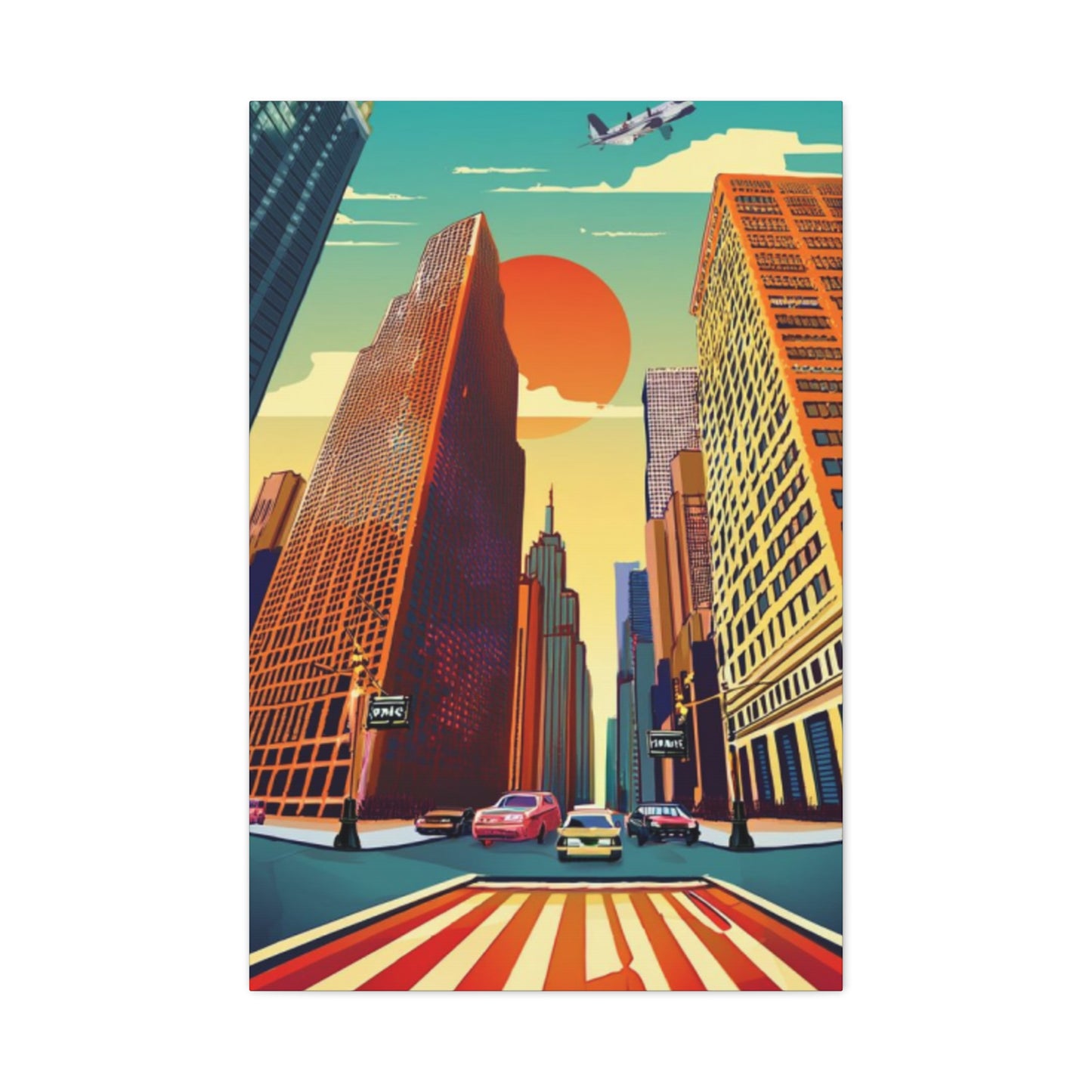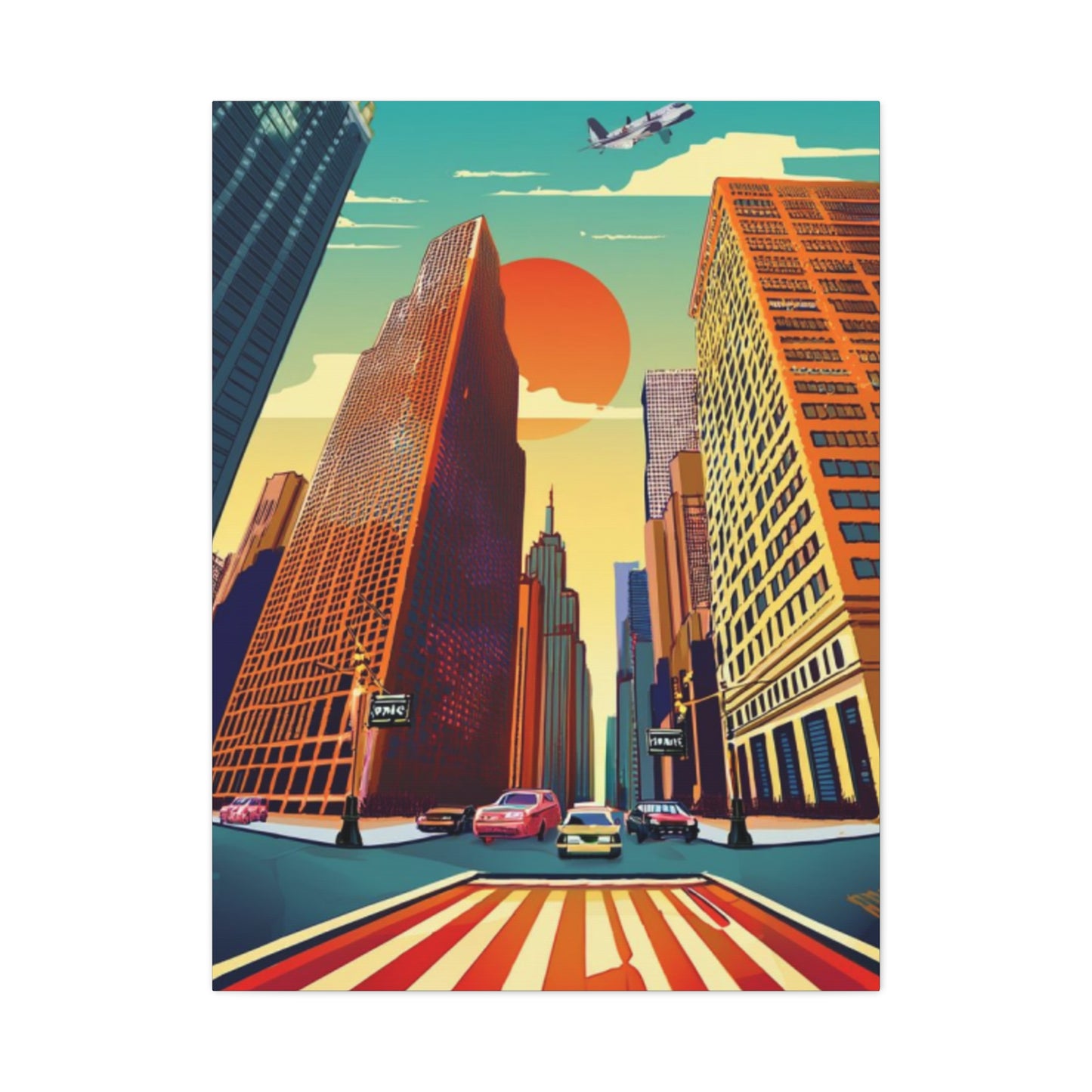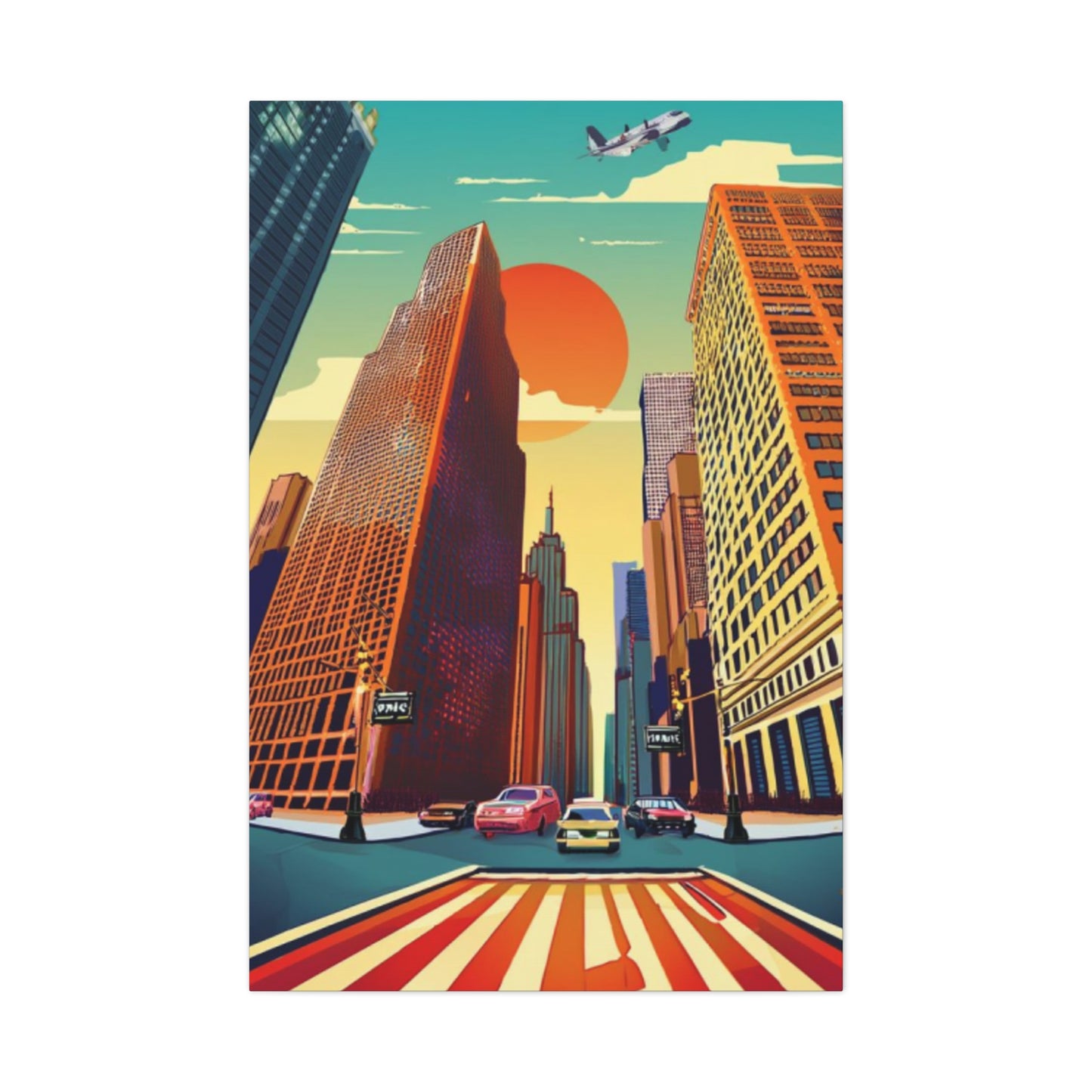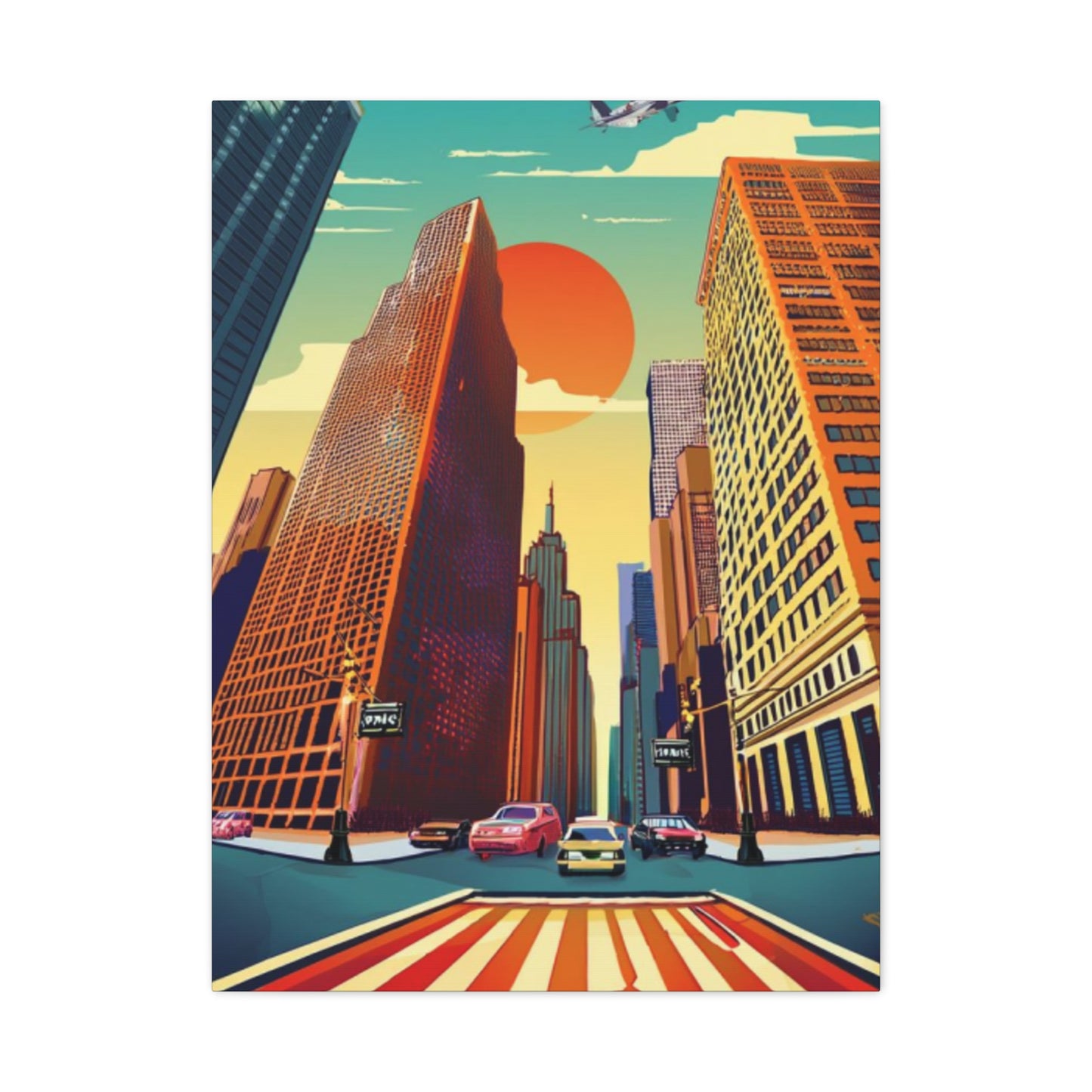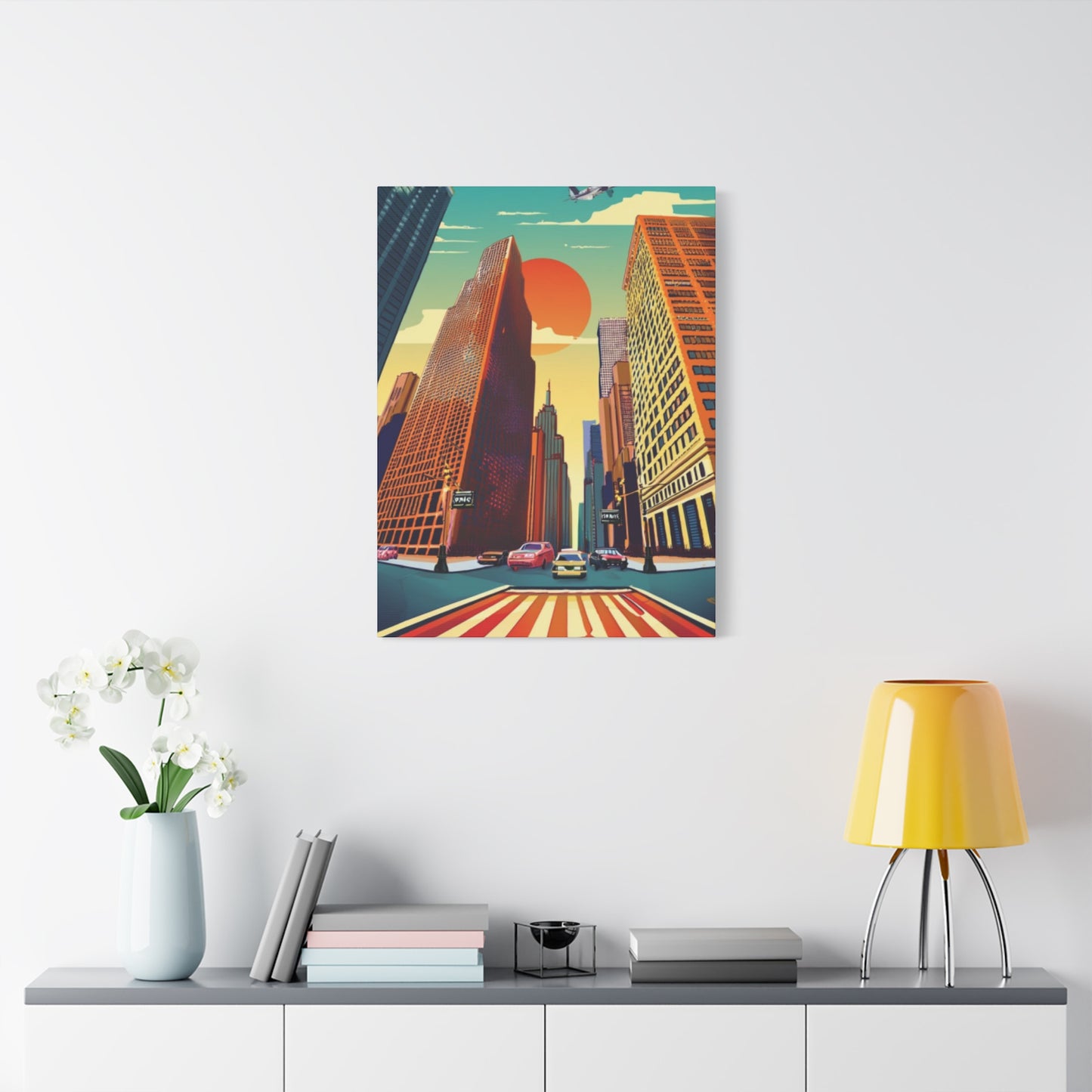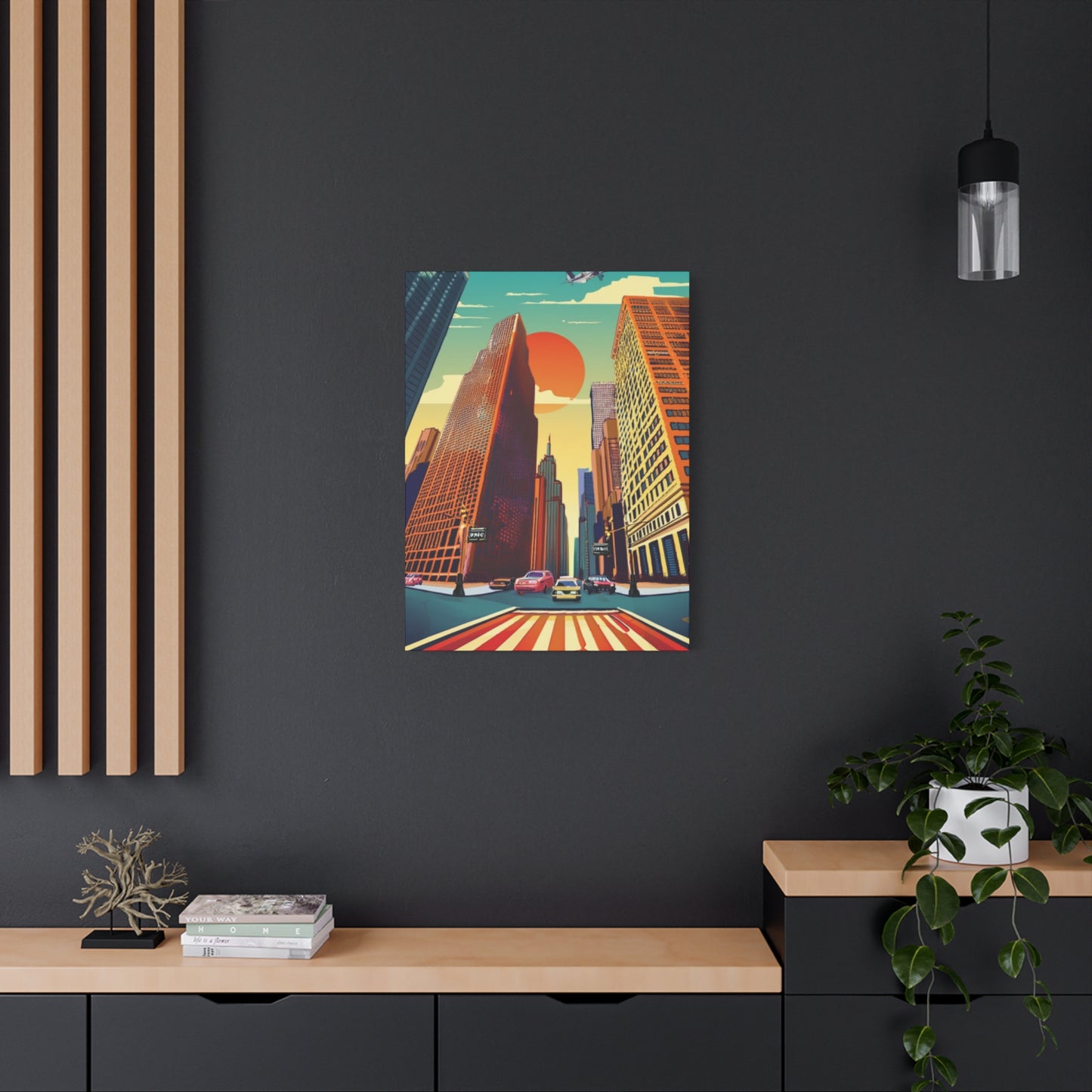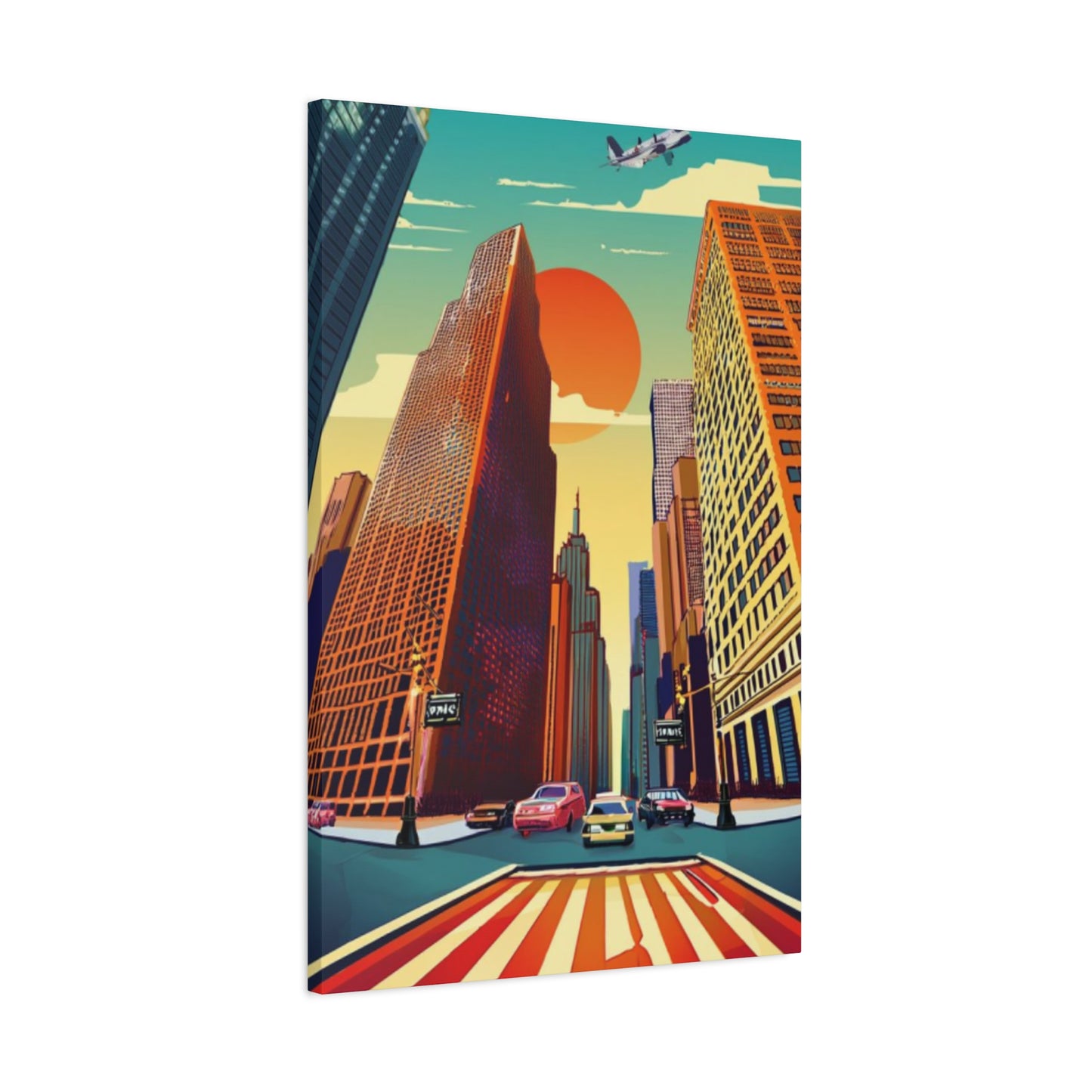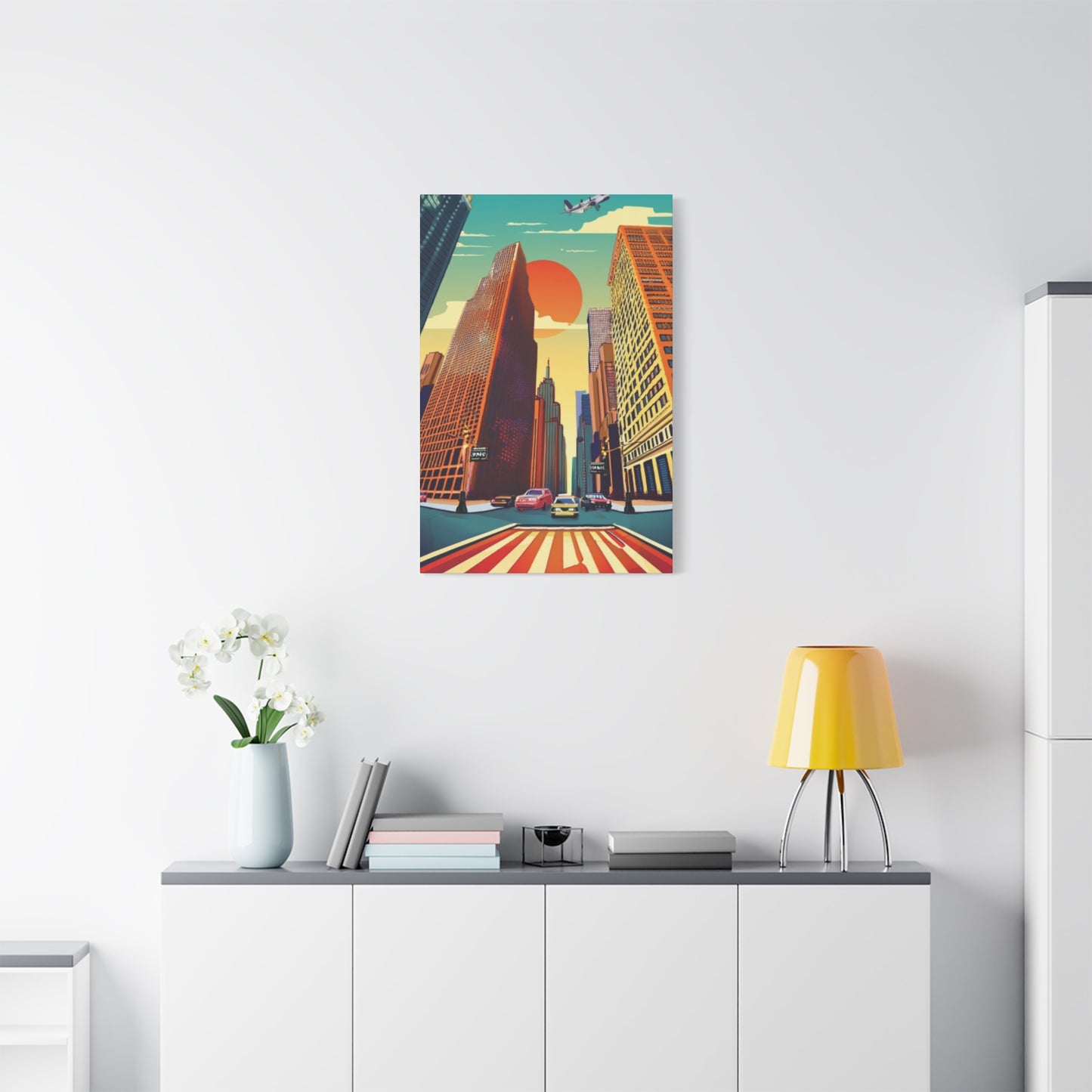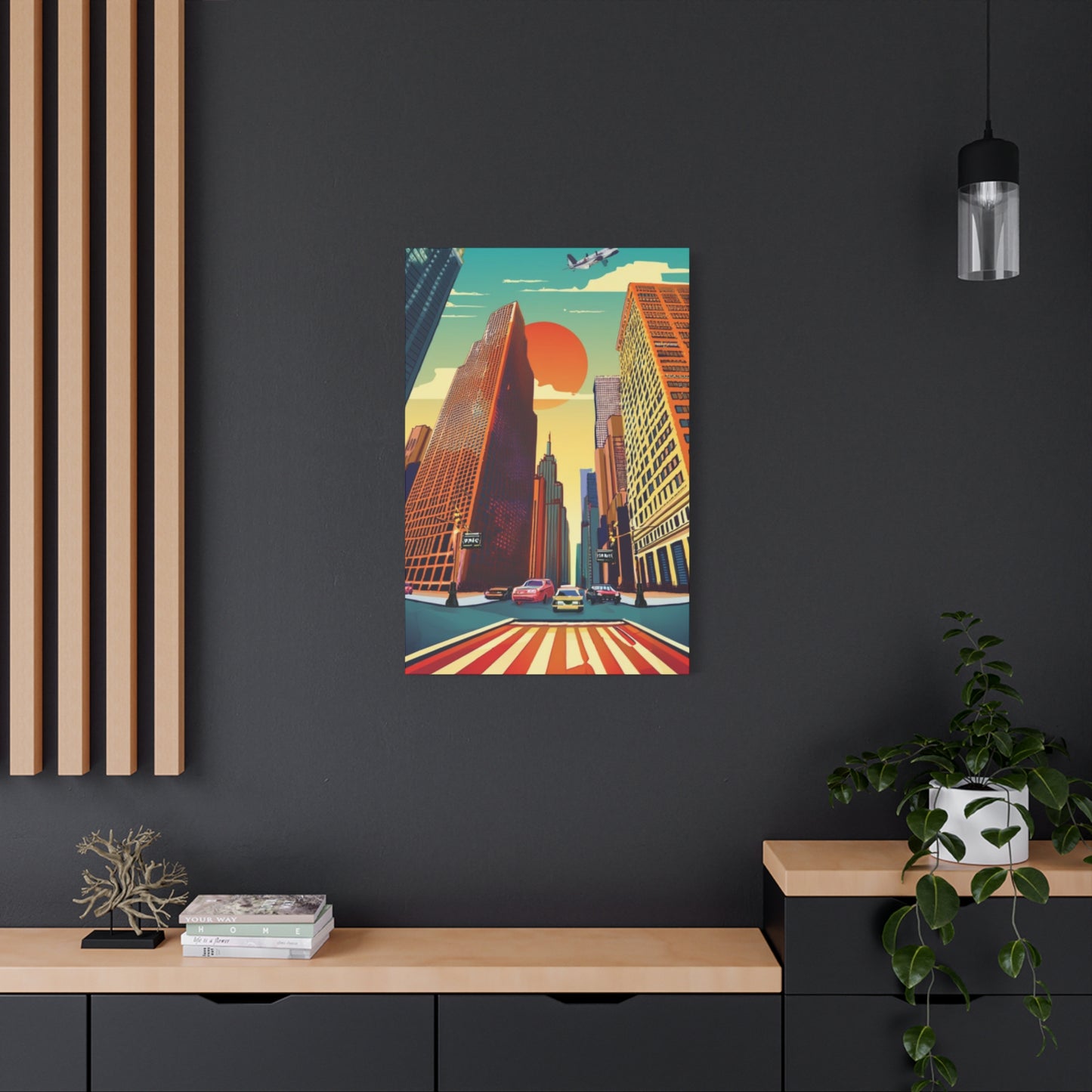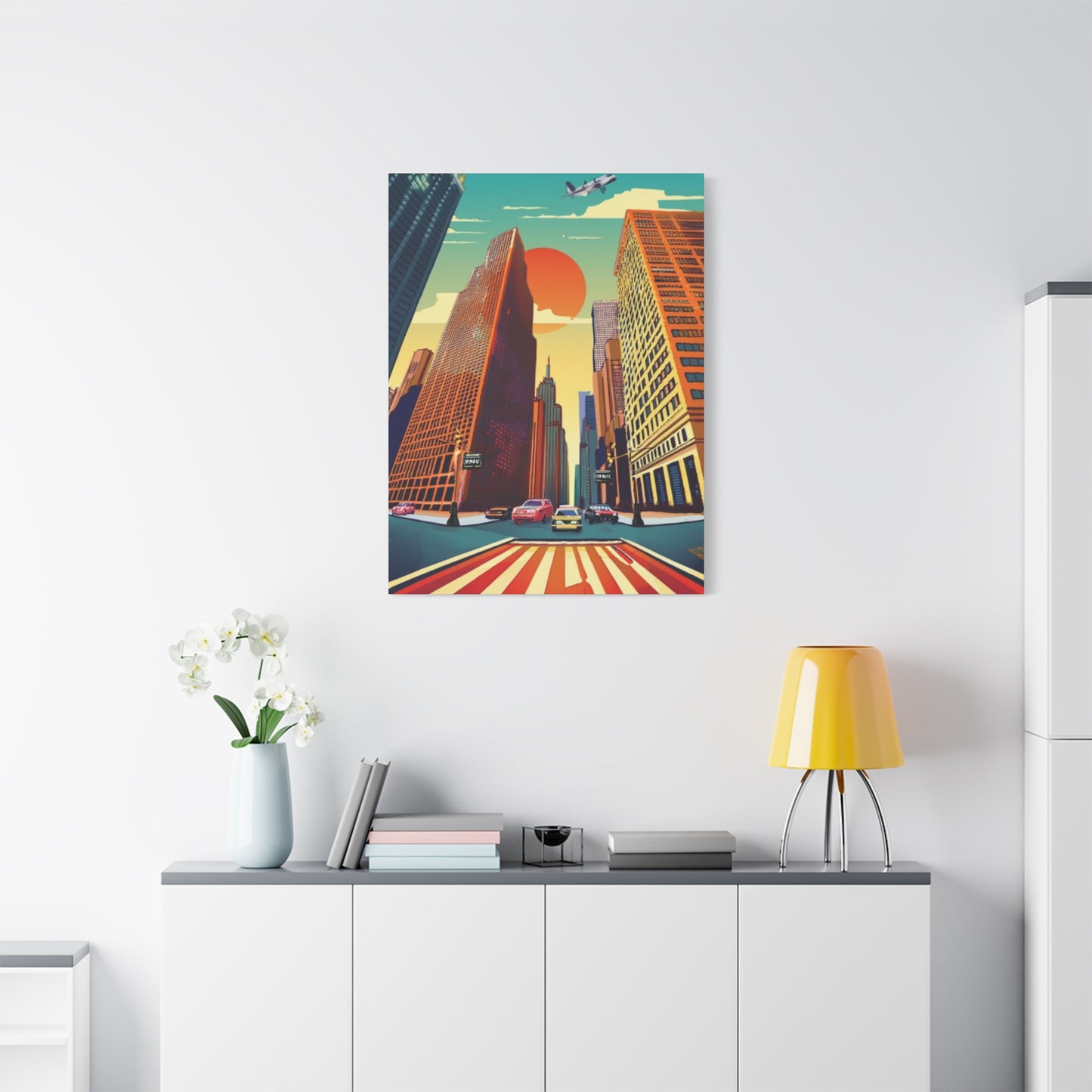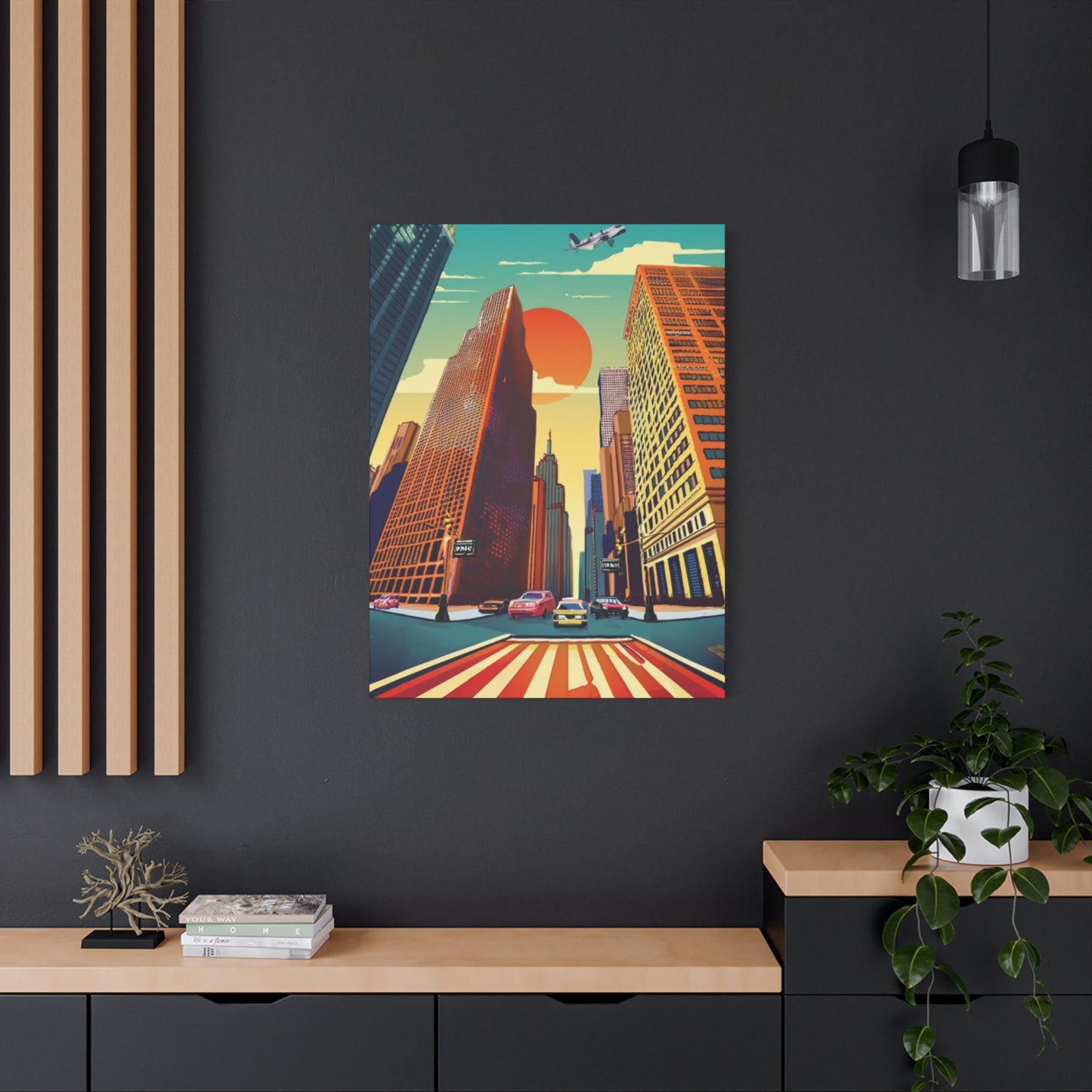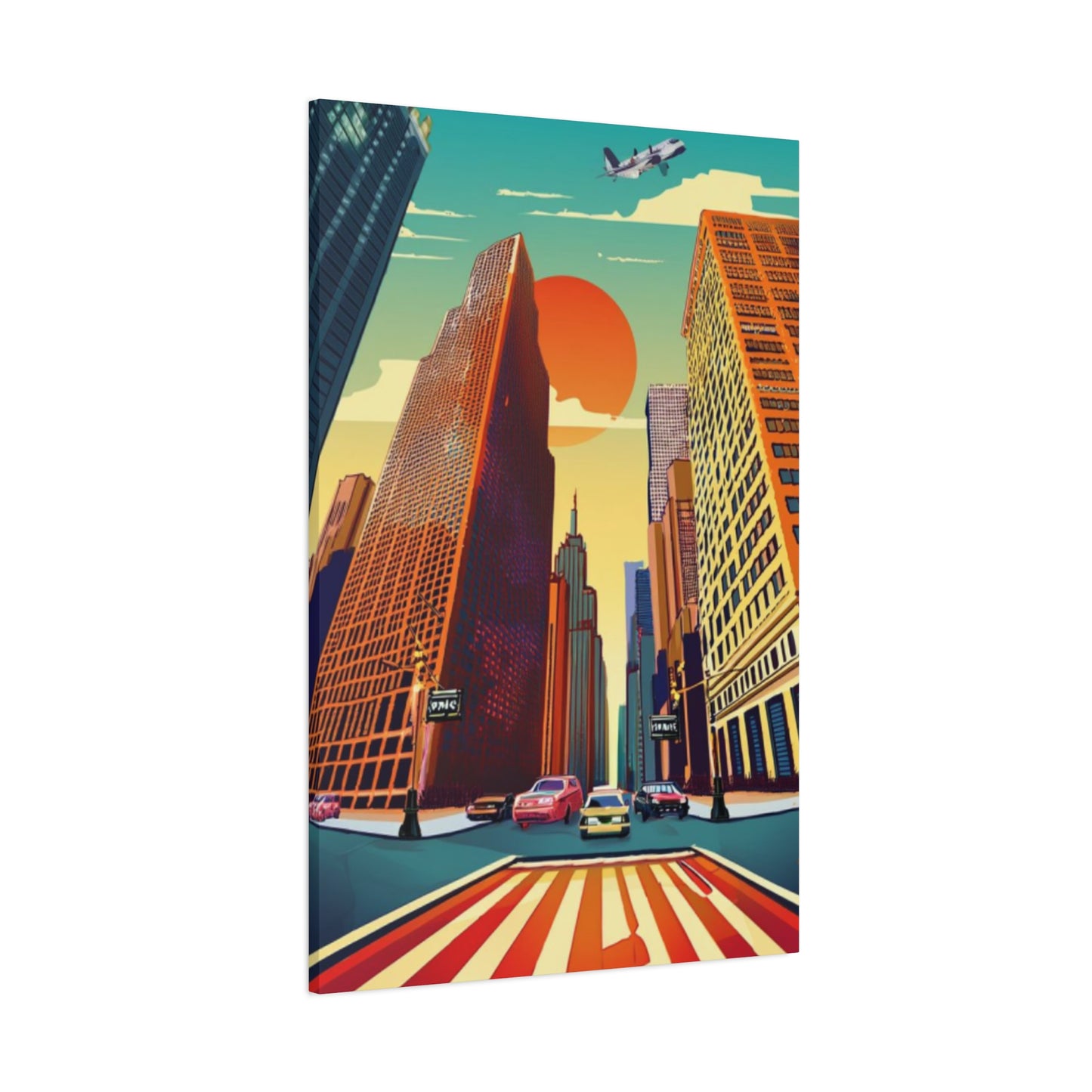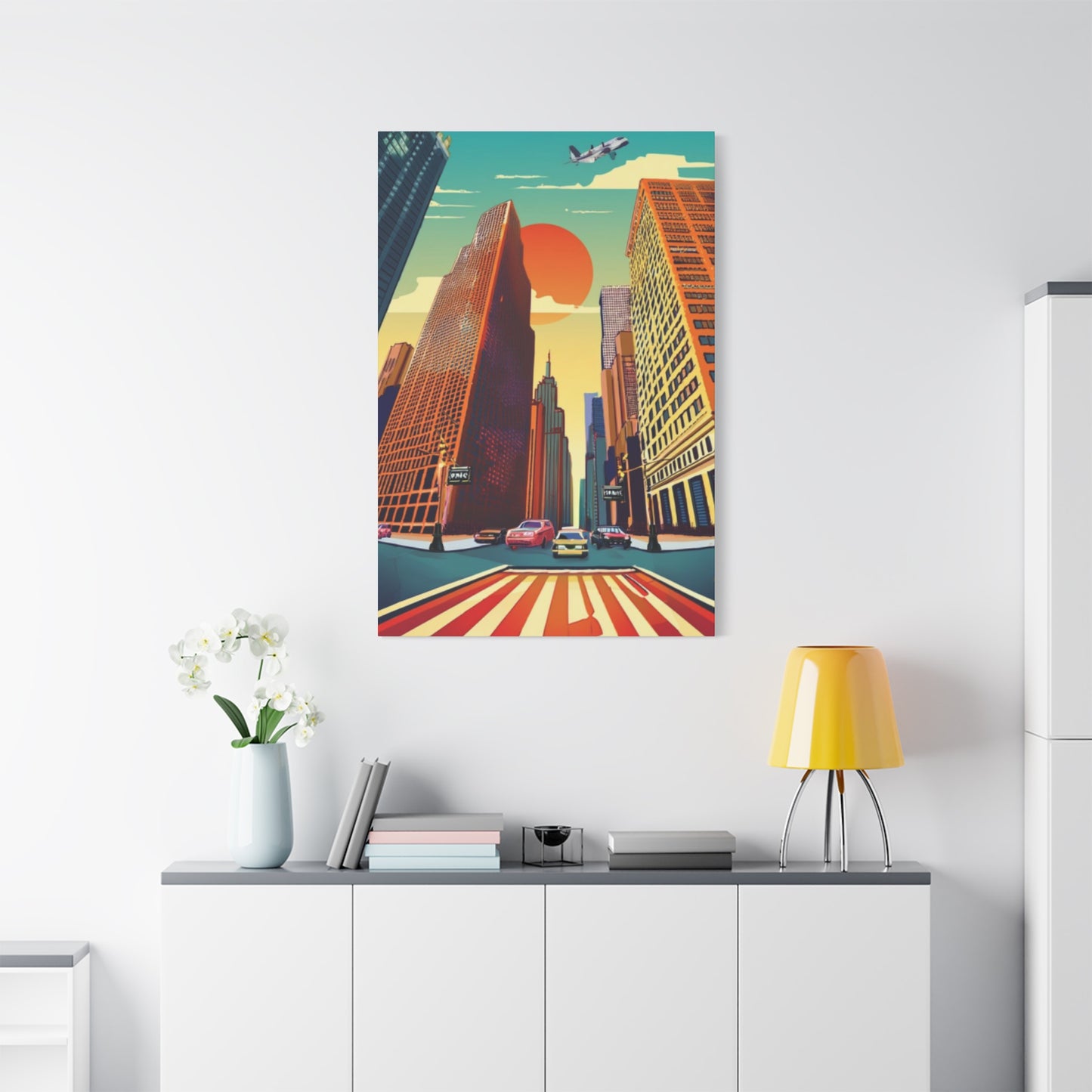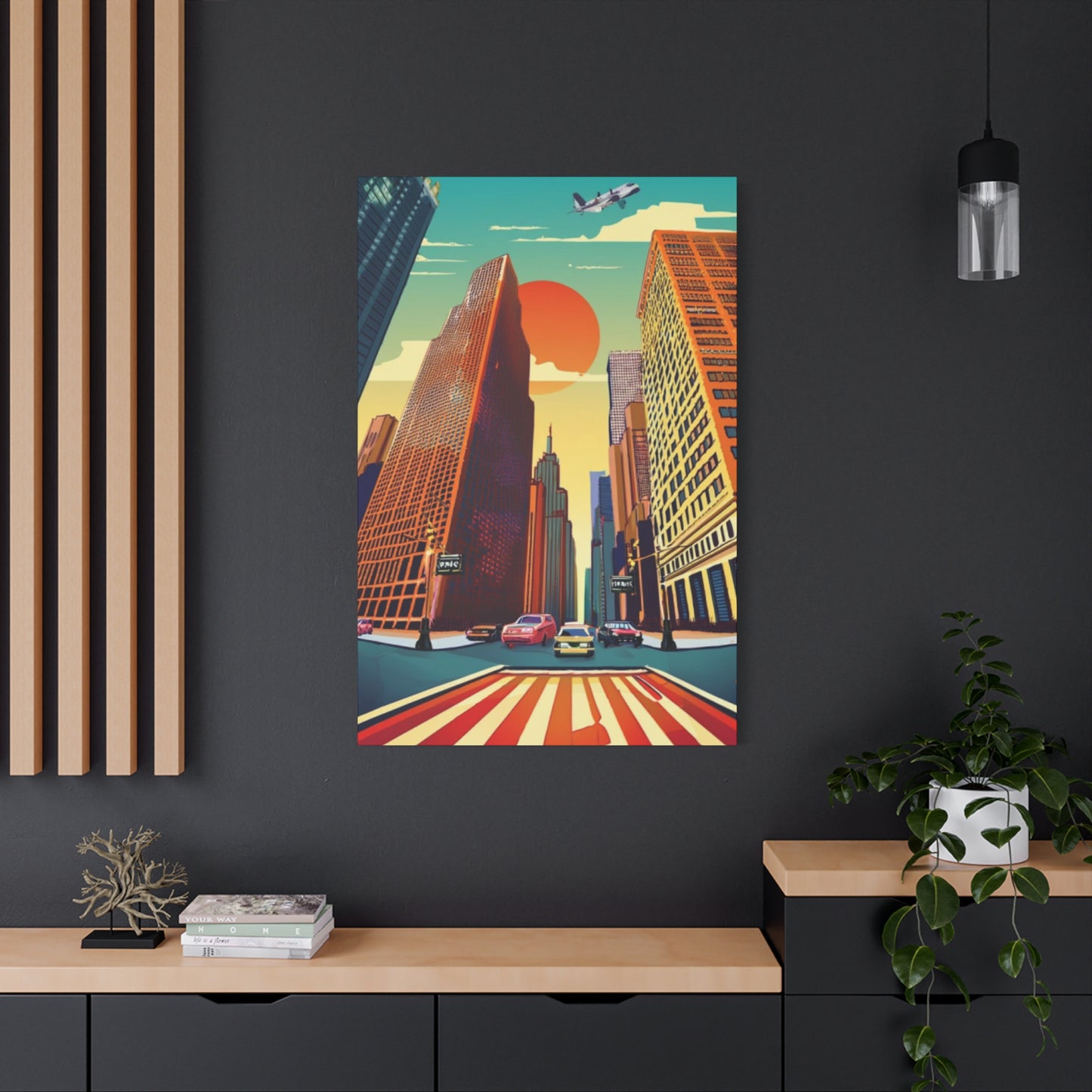Curved Perspectives: NYC Fish-Eye Photography skyline Wall Art Revolution
New York City has always been a muse for photographers and artists alike, but fish-eye photography has revolutionized how we perceive and display the urban landscape. This distinctive photographic technique creates spherical, curved images that capture an expansive view of the cityscape in a single frame, offering viewers an immersive experience that traditional photography simply cannot match. The distorted perspective created by fish-eye lenses transforms familiar NYC landmarks into abstract, almost surreal compositions that challenge our conventional understanding of urban photography.
Fish-eye photography of New York City represents more than just a technical achievement; it embodies a new artistic movement that celebrates the complexity and overwhelming nature of metropolitan life. The curved perspective mirrors the sensory overload that residents and visitors experience when navigating the city's towering skyscrapers, bustling streets, and endless human activity. This photographic style captures the essence of NYC's energy in a way that feels both familiar and completely alien, creating wall art that serves as conversation starters and focal points in contemporary interior design.
The popularity of fish-eye NYC photography has grown exponentially in recent years, driven by social media culture and the desire for unique visual content. However, beyond its trending status, this photography style offers genuine artistic merit and emotional impact. The distorted perspective creates a sense of movement and dynamism that reflects the perpetual motion of city life, making it particularly appealing for modern homes and commercial spaces that want to convey energy and sophistication.
Artists and photographers working with fish-eye lenses in NYC often describe the experience as liberating. The wide-angle perspective allows them to include elements that would normally require multiple shots, creating compositions that tell complete stories within a single frame. This comprehensive view of the urban environment resonates with viewers who have experienced the overwhelming yet exhilarating feeling of being surrounded by Manhattan's architectural giants or standing in the middle of Times Square during rush hour.
Historical Development of Fish-Eye Lens Technology in Urban Photography
The fish-eye lens was originally developed for meteorological and astronomical applications in the early 20th century, but its adoption into artistic photography began in the 1960s. The lens produces a distinctive circular or full-frame image with extreme wide-angle distortion, typically covering a field of view of 180 degrees or more. When applied to urban photography, particularly in dense metropolitan areas like New York City, the fish-eye lens creates unique visual effects that emphasize the vertical nature of the cityscape while simultaneously capturing the horizontal spread of streets and neighborhoods.
Early pioneers of fish-eye photography in urban settings faced significant technical challenges. The extreme curvature of the lens often resulted in exposure problems, with bright skies dominating dark street-level elements. However, these early adopters recognized the artistic potential of the distorted perspective and began experimenting with different shooting techniques and post-processing methods to overcome these limitations. Their work laid the foundation for contemporary fish-eye photography that has become increasingly sophisticated and accessible.
The digital revolution transformed fish-eye photography from a niche technique to a mainstream artistic medium. Digital sensors and advanced image processing software allowed photographers to correct some of the more problematic aspects of fish-eye distortion while preserving the dramatic visual impact that makes this style so compelling. Modern digital cameras with fish-eye lenses can capture incredible detail across the entire frame, making it possible to create large-scale wall art prints that maintain clarity and impact even at substantial viewing distances.
Professional photographers specializing in NYC fish-eye photography have developed specific techniques for maximizing the dramatic impact of their images. These include strategic positioning to emphasize the height and density of skyscrapers, timing shots to capture optimal lighting conditions, and using the curved perspective to create leading lines that draw viewers into the composition. The result is wall art that not only documents the physical reality of New York City but also conveys the emotional and psychological impact of urban living.
The evolution of fish-eye photography in NYC has been closely tied to changes in the city itself. As new architectural developments have transformed the skyline and street-level experience, photographers have adapted their techniques to capture these changes. The curved perspective of fish-eye lenses has proven particularly effective at documenting the vertical growth of the city, creating images that emphasize the dramatic scale of modern urban development while maintaining a human perspective at street level.
Technical Aspects of Fish-Eye Photography in Metropolitan Environments
Creating compelling fish-eye photography in New York City requires a deep understanding of both the technical limitations and creative possibilities of ultra-wide-angle lenses. Fish-eye lenses typically range from 8mm to 16mm in focal length, with the most extreme versions producing a complete circular image surrounded by black borders. The extreme angle of view captured by these lenses creates distinctive distortion patterns that become more pronounced toward the edges of the frame, resulting in the characteristic curved horizon lines and stretched perspective that define the fish-eye aesthetic.
The physics of fish-eye lens design involves complex mathematical calculations to project a three-dimensional scene onto a two-dimensional sensor or film plane. Unlike rectilinear lenses that maintain straight lines, fish-eye lenses intentionally introduce curvature to accommodate the extremely wide field of view. This curvature creates unique challenges when photographing architectural subjects like NYC skyscrapers, as vertical lines become increasingly curved as they move away from the center of the frame. However, skilled photographers have learned to use this distortion creatively, positioning their cameras to emphasize the soaring height of buildings while creating dynamic, flowing compositions.
Exposure considerations in fish-eye photography require careful attention to the extreme contrast often present in urban environments. A single fish-eye frame of NYC might include deep shadows cast by skyscrapers alongside bright sky visible between buildings, creating exposure challenges that require either HDR techniques or careful metering to preserve detail in both highlights and shadows. Many contemporary photographers use graduated neutral density filters or bracket multiple exposures to capture the full dynamic range of the urban environment.
Focus considerations in fish-eye photography are equally complex. The extreme depth of field characteristics of ultra-wide-angle lenses mean that almost everything in the frame will appear sharp when focused at hyperfocal distance, but the curved perspective can create unusual visual relationships between foreground and background elements. Photographers must carefully consider how the distortion will affect the apparent size and position of objects at different distances from the camera, as the fish-eye perspective can make nearby objects appear dramatically larger while compressing distant elements.
Color rendition and contrast in fish-eye NYC photography present unique opportunities and challenges. The wide field of view often includes diverse lighting conditions within a single frame, from cool shadows cast by buildings to warm reflections from glass surfaces. The curved perspective can also create interesting color gradations across the frame, as the distortion affects how light enters the lens from different angles. Skilled photographers use these characteristics to create wall art with rich, complex color palettes that reflect the diverse visual environment of New York City.
Compositional Strategies for NYC Fish-Eye Wall Art
Creating visually compelling fish-eye photographs of New York City requires mastering compositional techniques specifically adapted to the unique characteristics of ultra-wide-angle distortion. Traditional compositional rules like the rule of thirds must be reconsidered when working with fish-eye lenses, as the curved perspective fundamentally changes how elements within the frame relate to each other. Instead, photographers must think in terms of circular and radial compositions that work harmoniously with the lens distortion rather than fighting against it.
Central positioning becomes critically important in fish-eye photography, as elements placed at the center of the frame remain relatively undistorted while those toward the edges become increasingly curved. Skilled NYC fish-eye photographers often position iconic landmarks like the Chrysler Building or One World Trade Center at the center of their compositions, allowing the surrounding cityscape to curve dramatically around these focal points. This technique creates wall art with strong visual anchors while showcasing the dynamic energy of the urban environment.
Leading lines take on new meaning in fish-eye photography, as straight elements like streets, sidewalks, and building edges become curved guides that draw viewers into the composition. NYC's grid street system provides excellent opportunities for creating radial compositions where multiple streets appear to emanate from a central point, enhanced by the fish-eye distortion. These curved leading lines can create powerful visual flow that moves the viewer's eye throughout the entire composition, making the wall art engaging from both close and distant viewing positions.
Foreground elements become dramatically important in fish-eye NYC photography due to the extreme wide-angle perspective. Objects placed close to the camera appear disproportionately large and can dominate the composition if not carefully considered. However, when used skillfully, prominent foreground elements like street lamps, fire hydrants, or pedestrians can add human scale and context to images dominated by towering architecture. The key is positioning these elements where the distortion enhances rather than detracts from their visual impact.
Symmetrical compositions work particularly well with fish-eye lenses, as the radial distortion can create pleasing balance around the center of the frame. NYC offers numerous opportunities for symmetrical fish-eye compositions, from looking up between parallel skyscrapers to capturing the curved perspective of bridge structures. These symmetrical arrangements often result in wall art with strong geometric appeal that complements contemporary interior design while maintaining the dynamic energy characteristic of urban photography.
Layering and depth become complex considerations in fish-eye photography due to the way the distortion compresses and expands different areas of the frame. Photographers must carefully consider how foreground, middle ground, and background elements will interact when viewed through the curved perspective. The fish-eye effect can create interesting visual relationships between elements at different distances, sometimes making distant objects appear to wrap around closer ones in visually engaging ways that add complexity and interest to the final wall art.
Color Theory and Fish-Eye NYC Photography
The application of color theory to fish-eye photography of New York City creates opportunities for wall art that not only captures the visual drama of urban landscapes but also evokes specific emotional responses through carefully orchestrated color relationships. The extreme wide-angle perspective of fish-eye lenses often incorporates diverse color palettes within a single frame, from the warm tones of brick buildings and yellow taxi cabs to the cool blues of glass skyscrapers and overcast skies. Managing these complex color interactions requires both technical skill and artistic vision.
Color temperature variations across a fish-eye frame can create visually striking contrasts that enhance the three-dimensional feeling of the curved perspective. NYC's urban environment provides rich opportunities for exploring these temperature differences, as shadows cast by buildings often exhibit cool blue tones while sunlit surfaces reflect warm golden light. The fish-eye distortion can emphasize these temperature variations by positioning contrasting areas at different distances from the lens, creating depth and visual interest that translates effectively to large-scale wall art.
Complementary color schemes work particularly well in fish-eye NYC photography, as the curved perspective naturally separates different areas of the frame while maintaining visual unity. The classic blue and orange combination often occurs naturally in urban environments, with blue skies or glass buildings contrasting against the warm tones of brick architecture or golden hour sunlight. Fish-eye photographers can enhance these natural color relationships through careful timing and positioning, creating wall art with powerful visual impact and emotional resonance.
Monochromatic color schemes in fish-eye photography can create sophisticated, gallery-worthy wall art that emphasizes form and texture over color variety. NYC's architecture provides excellent subjects for monochromatic treatments, particularly during overcast conditions when color saturation is naturally reduced. The fish-eye distortion can enhance the sculptural qualities of buildings and urban structures, creating images that work well in minimalist interior design schemes where subtle color variations are preferred over bold contrasts.
Seasonal color changes in New York City provide fish-eye photographers with opportunities to create series of related images that can be displayed together as cohesive wall art collections. The curved perspective of fish-eye lenses is particularly effective at capturing the transition between seasons, from the fresh greens of spring foliage in Central Park to the warm golds and reds of autumn leaves. These seasonal variations can be enhanced through careful post-processing to create wall art that reflects the natural cycles of urban life.
Color psychology considerations become important when creating fish-eye NYC wall art for specific interior design applications. Warm color palettes can make large spaces feel more intimate and welcoming, while cool color schemes can enhance the feeling of spaciousness and modernity. The curved perspective of fish-eye photography naturally creates visual movement that can be enhanced or subdued through color choices, allowing photographers to create wall art that complements specific architectural and decorational contexts.
Lighting Conditions and Their Impact on Fish-Eye NYC Photography
The quality and direction of light fundamentally influence the visual impact and emotional resonance of fish-eye photography in New York City's urban environment. The extreme wide-angle perspective of fish-eye lenses captures lighting conditions across a broad field of view, often incorporating multiple light sources and shadow patterns within a single frame. This complexity requires photographers to develop sophisticated understanding of how different lighting scenarios affect the curved perspective and overall composition of their wall art.
Golden hour lighting provides some of the most dramatic opportunities for fish-eye NYC photography, as the low angle of the sun creates long shadows and warm color temperatures that enhance the three-dimensional quality of the curved perspective. During these optimal lighting conditions, the fish-eye distortion can create sweeping shadow patterns that curve gracefully across streets and building faces, adding visual movement and depth to the composition. The warm light also enhances the contrast between illuminated and shadowed areas, creating wall art with rich tonal variations and emotional warmth.
Blue hour photography, occurring just after sunset when the sky maintains deep blue coloration while artificial lights begin to illuminate the urban landscape, offers unique opportunities for fish-eye compositions. The curved perspective can capture both the expansive sky and the intricate patterns of street lights and building illumination within a single frame. This lighting condition creates wall art with a sophisticated color palette and mysterious atmosphere that works particularly well in contemporary interior design schemes.
Overcast conditions, while often considered less favorable for traditional photography, can provide excellent opportunities for fish-eye NYC wall art. The soft, even illumination eliminates harsh shadows and reduces contrast, allowing the curved perspective and architectural forms to become the primary visual elements. Under overcast skies, the fish-eye distortion can create subtle gradations of tone and color that emphasize the sculptural qualities of urban architecture while maintaining detail throughout the entire frame.
Artificial lighting in NYC's urban environment creates unique challenges and opportunities for fish-eye photographers. The curved perspective can create interesting patterns from street lights, neon signs, and illuminated building facades, but the extreme wide-angle view often incorporates multiple light sources with different color temperatures. Skilled photographers learn to use these mixed lighting conditions creatively, either embracing the color variations for visual interest or using post-processing techniques to harmonize the different light sources for more cohesive wall art.
Backlighting and silhouette effects can be particularly dramatic in fish-eye NYC photography, as the curved perspective can create halo effects around architectural elements while maintaining detail in shadowed areas. The extreme wide-angle view often allows photographers to position the sun or other bright light sources within the frame while including substantial amounts of surrounding detail, creating wall art with strong contrast and dynamic visual impact that commands attention in interior spaces.
Post-Processing Techniques for Fish-Eye NYC Wall Art
The post-processing phase of fish-eye NYC photography represents a crucial creative opportunity to enhance the unique characteristics of the curved perspective while optimizing images for large-scale wall art applications. Unlike traditional wide-angle photography, fish-eye images require specialized processing techniques that work with the inherent distortion rather than attempting to correct it. The goal is to create visually compelling wall art that celebrates the distinctive fish-eye aesthetic while maintaining technical quality suitable for professional display applications.
Lens correction decisions represent one of the most important post-processing considerations for fish-eye photography. While software applications offer automatic correction options that can transform fish-eye images into rectilinear perspectives, this approach often eliminates the unique visual character that makes fish-eye photography compelling. Instead, skilled photographers typically apply selective corrections that reduce problematic distortions while preserving the curved perspective that defines the fish-eye aesthetic. This approach maintains the artistic integrity of the original vision while creating wall art that is visually comfortable for extended viewing.
Color grading and tone mapping in fish-eye NYC photography require careful attention to the way distortion affects color and contrast across the frame. The curved perspective can create uneven color distribution, with certain areas appearing more saturated or contrasty than others due to the lens characteristics and varied lighting conditions within the wide field of view. Advanced color grading techniques allow photographers to create more balanced color distributions while preserving the natural variations that contribute to the three-dimensional quality of the image.
Selective adjustments become particularly important in fish-eye post-processing due to the diverse range of lighting and compositional elements typically present within a single frame. Local adjustment tools allow photographers to optimize different areas of the image independently, brightening shadowed street-level details while preserving sky highlights, or enhancing the saturation of specific architectural elements without affecting the overall color balance. These selective adjustments are crucial for creating wall art that maintains visual interest and detail at large print sizes.
Sharpening and detail enhancement require specialized approaches for fish-eye photography, as traditional sharpening algorithms may not work effectively with the curved perspective and variable distortion across the frame. Photographers often use masking techniques to apply different levels of sharpening to different areas of the image, ensuring that both central and peripheral elements maintain appropriate detail levels for large-scale printing. This selective approach to detail enhancement helps create wall art that remains visually engaging when viewed from various distances.
Print preparation for fish-eye NYC wall art involves additional considerations beyond standard image processing. The curved perspective and extreme wide-angle content often benefit from larger print sizes to fully convey the immersive quality of the original scene, but this requires careful attention to resolution and file preparation. Many photographers create multiple versions of their fish-eye images optimized for different print sizes and viewing distances, ensuring that the wall art maintains visual impact whether displayed in intimate residential settings or large commercial spaces.
Interior Design Integration of Fish-Eye NYC Wall Art
Incorporating fish-eye photography of New York City into interior design schemes requires careful consideration of both the unique visual characteristics of the curved perspective and the spatial relationships within the room. The dynamic, immersive quality of fish-eye images can dramatically transform the atmosphere of interior spaces, creating focal points that add energy and visual interest while reflecting contemporary urban aesthetics. However, the success of this integration depends on thoughtful planning that considers scale, placement, and complementary design elements.
Scale considerations become particularly important when displaying fish-eye NYC wall art, as the immersive quality of the curved perspective often benefits from larger print sizes that allow viewers to experience the full impact of the wide-angle view. Large-scale fish-eye prints can create the illusion of expanded space within interior environments, particularly when positioned on walls that face seating areas or primary traffic patterns. The curved perspective naturally draws viewers into the image, creating a sense of depth and movement that can make rooms feel more dynamic and spacious.
Placement strategies for fish-eye wall art should consider the viewing angles and distances from which the artwork will typically be seen. The radial composition of fish-eye images works well when displayed at eye level or slightly above, allowing viewers to appreciate both the central focal point and the curved peripheral elements. Corner installations can be particularly effective for fish-eye NYC photography, as the angular placement can enhance the three-dimensional quality of the curved perspective while creating interesting relationships with the architectural elements of the room.
Lighting design plays a crucial role in optimizing the visual impact of fish-eye NYC wall art within interior spaces. The complex tonal ranges and detail variations typical of fish-eye urban photography require even, high-quality illumination that preserves both highlight and shadow detail. LED track lighting or adjustable picture lights can provide optimal illumination while minimizing glare and reflection issues that might interfere with the viewing experience. The lighting should enhance rather than compete with the dramatic lighting effects captured within the fish-eye photograph.
Color coordination between fish-eye NYC wall art and interior design elements requires consideration of the complex color palettes typically present in urban photography. The curved perspective often incorporates diverse color ranges within a single frame, from warm architectural tones to cool sky colors. Interior designers can use this color complexity as an opportunity to create sophisticated color schemes that draw specific hues from the artwork while maintaining overall design coherence. This approach allows the wall art to serve as both a focal point and a unifying element within the room's color palette.
Furniture and accessory placement around fish-eye wall art should complement rather than compete with the dynamic energy of the curved perspective. Clean, contemporary furniture lines often work well with the modern aesthetic of fish-eye photography, while avoiding overly ornate or traditional pieces that might clash with the urban, technological feel of the artwork. The goal is to create interior environments where the fish-eye NYC photography enhances the overall design concept while maintaining its own visual integrity and impact.
Architectural Elements in Fish-Eye NYC Photography
The distinctive architectural landscape of New York City provides fish-eye photographers with an unparalleled variety of structural elements that are transformed and enhanced by the curved perspective of ultra-wide-angle lenses. From the Art Deco spires of the Chrysler Building to the sleek glass facades of modern skyscrapers, the city's diverse architectural styles create unique opportunities for fish-eye compositions that celebrate both historical and contemporary design elements within single frames.
Skyscraper photography through fish-eye lenses creates dramatic vertical compositions that emphasize the soaring height and imposing scale of NYC's most iconic buildings. The curved perspective transforms straight vertical lines into graceful curves that seem to bend toward the viewer, creating a sense of movement and energy that reflects the dynamic nature of urban life. When positioned at the base of tall buildings and shooting upward, fish-eye photographers can capture the entire height of structures while including substantial amounts of surrounding context, creating wall art that conveys both the individual character of specific buildings and their relationship to the broader urban environment.
Bridge structures throughout New York City offer exceptional subjects for fish-eye photography due to their combination of architectural engineering and sculptural beauty. The Brooklyn Bridge, Manhattan Bridge, and Williamsburg Bridge each provide unique compositional opportunities when viewed through fish-eye lenses. The curved perspective can emphasize the graceful suspension cable patterns while capturing the relationship between the bridge structure and surrounding architectural elements. These compositions often result in wall art with strong geometric elements and dynamic visual flow that works well in contemporary interior design applications.
Historic architectural elements, from brownstone facades to cast-iron building details, take on new visual significance when captured through fish-eye lenses. The curved perspective can reveal architectural relationships and patterns that are not immediately apparent in traditional photography, creating images that offer fresh perspectives on familiar urban elements. The distortion can emphasize the rhythmic patterns of repeated architectural elements like windows, balconies, and cornices, creating wall art with strong graphic appeal and historical resonance.
Modern glass architecture presents unique opportunities and challenges for fish-eye NYC photography. The reflective surfaces of contemporary skyscrapers can create complex visual interactions when captured through curved perspectives, with reflections and transparencies creating layered compositions that add depth and visual complexity. The fish-eye distortion can enhance these effects, creating wall art that captures the technological sophistication and visual drama of contemporary urban architecture while maintaining the human perspective that makes the images emotionally engaging.
Architectural details and ornamental elements throughout NYC become magnified and emphasized through fish-eye photography techniques. The extreme wide-angle perspective allows photographers to include substantial amounts of architectural detail while maintaining the broader context of surrounding structures. This approach creates wall art that celebrates both the grand scale of urban architecture and the intricate craftsmanship and design elements that contribute to the city's distinctive character. The curved perspective can reveal design relationships and visual patterns that contribute to the overall aesthetic impact of the urban environment.
Street Level Perspectives in Fish-Eye NYC Photography
Street level fish-eye photography in New York City captures the human experience of navigating the urban environment, creating wall art that conveys both the overwhelming scale of the city and the intimate details of daily life. The curved perspective of fish-eye lenses is particularly effective at street level because it can simultaneously capture the towering buildings above and the intricate patterns of street furniture, signage, and human activity below, creating compositions that reflect the multi-layered nature of urban experience.
Pedestrian perspectives form a crucial element of street level fish-eye photography, as the curved lens can capture the flow and movement of people navigating city sidewalks while maintaining the architectural context that frames their activity. The distortion created by fish-eye lenses can emphasize the dynamic nature of pedestrian movement, creating wall art that conveys energy and life rather than static architectural documentation. These human elements provide scale references that help viewers understand the massive proportions of surrounding buildings while adding emotional warmth and relatability to urban photography.
Traffic patterns and vehicle movement create additional opportunities for dynamic street level fish-eye compositions. The curved perspective can capture the flowing lines of traffic movement while including the architectural boundaries that channel and direct urban transportation. Yellow taxi cabs, buses, and delivery vehicles become compositional elements that add color and movement to fish-eye NYC photography, creating wall art that reflects the constant motion and energy that characterizes city life.
Street furniture and urban infrastructure elements like lamp posts, fire hydrants, subway entrances, and traffic signals take on enhanced visual significance when captured through fish-eye lenses. The extreme wide-angle perspective can transform these utilitarian objects into sculptural elements that contribute to the overall composition while maintaining their functional context. The curved distortion often emphasizes the relationship between these human-scale elements and the towering architecture that surrounds them, creating visual narratives about urban life and the systems that support city functioning.
Storefront and retail elements at street level provide colorful and varied compositional opportunities for fish-eye NYC photography. The curved perspective can capture entire streetscapes that include diverse retail establishments, signage, and architectural details while maintaining the broader urban context. These compositions often result in wall art that celebrates the commercial vitality and cultural diversity of New York City neighborhoods, creating images that are both visually compelling and culturally significant.
Shadow patterns and lighting effects at street level become particularly dramatic when captured through fish-eye lenses due to the extreme wide-angle perspective that can include both shadowed street areas and bright sky regions within single frames. The curved distortion can emphasize the geometric patterns created by building shadows while capturing the complex lighting conditions that change throughout the day as the sun moves across the urban sky. These lighting effects contribute to wall art that conveys the temporal nature of urban experience while maintaining strong visual impact and compositional interest.
Seasonal Variations in Fish-Eye NYC Photography
The changing seasons in New York City provide fish-eye photographers with continuously evolving opportunities to capture the urban landscape under different atmospheric conditions, lighting scenarios, and natural elements. Each season brings distinctive visual characteristics that interact uniquely with the curved perspective of fish-eye lenses, creating opportunities for wall art series that document the temporal changes in urban environments while maintaining the dramatic visual impact characteristic of fish-eye photography.
Spring conditions in NYC create opportunities for fish-eye photography that incorporates the fresh green foliage of parks and street trees with the permanent architectural elements of the urban landscape. The curved perspective can capture expansive views of Central Park or smaller neighborhood green spaces while including surrounding skyscrapers and residential buildings, creating compositions that celebrate the integration of natural and built environments within the city. The soft light and moderate contrast of spring conditions often result in wall art with gentle color palettes and optimistic emotional tones.
Summer lighting conditions provide the most dramatic opportunities for fish-eye NYC photography, with intense sunlight creating strong contrast between shadowed street areas and bright sky regions. The curved perspective can capture the full intensity of summer light while including the cooling shade provided by building overhangs and tree canopies. Long summer days also provide extended golden hour periods that create optimal lighting conditions for fish-eye photography, resulting in wall art with warm color temperatures and rich tonal variations.
Autumn in New York City offers fish-eye photographers spectacular opportunities to capture the changing colors of urban foliage integrated with architectural elements. The curved perspective can include extensive views of autumn colors while maintaining the urban context that makes NYC photography distinctive. The moderate lighting conditions of autumn often provide optimal contrast ratios for fish-eye photography, creating wall art with rich color saturation and excellent detail retention across the entire curved frame.
Winter conditions present unique challenges and opportunities for fish-eye NYC photography, as snow and ice can transform the familiar urban landscape into dramatically different visual compositions. The curved perspective can capture expansive snow-covered scenes while including the architectural elements that remain constant throughout seasonal changes. Winter lighting conditions, with low sun angles and crisp atmospheric clarity, often result in exceptional contrast and color separation that translates effectively to high-impact wall art.
Weather variations throughout all seasons provide additional opportunities for dramatic fish-eye NYC photography. Storm clouds, fog, and precipitation create atmospheric conditions that interact dramatically with the curved perspective, often resulting in moody, atmospheric wall art that conveys the dramatic weather events that periodically transform the urban environment. These atmospheric conditions can add mystery and drama to fish-eye compositions while maintaining the architectural and urban elements that anchor the images in their NYC context.
Digital vs Film Fish-Eye Photography in NYC
The choice between digital and film capture for fish-eye NYC photography significantly impacts both the technical process and artistic possibilities available to photographers creating wall art. Each medium offers distinct advantages and creative opportunities that influence the final visual character and emotional impact of fish-eye urban photography, requiring photographers to consider their artistic goals and technical requirements when selecting capture methods.
Digital fish-eye photography provides immediate feedback and extensive post-processing flexibility that can be particularly valuable when working in the challenging lighting conditions common in NYC urban environments. Digital sensors can capture impressive detail across the wide dynamic range typically present in fish-eye compositions, from deep building shadows to bright sky areas. The ability to review images immediately and adjust camera settings accordingly allows photographers to optimize their captures for specific wall art applications, ensuring proper exposure and composition before leaving a location.
Film-based fish-eye photography offers distinctive aesthetic characteristics that many artists and collectors find appealing for wall art applications. Film grain and color rendition create organic textures and color relationships that can enhance the emotional impact of fish-eye NYC photography. The more limited dynamic range of film often requires photographers to make careful exposure decisions that can result in more dramatic contrast and mood than digital alternatives. Many photographers working in film describe a more contemplative, deliberate approach to composition that can result in more thoughtfully constructed wall art.
Color characteristics differ significantly between digital and film fish-eye photography, with implications for wall art that will be viewed under various lighting conditions. Film emulsions often produce more saturated colors and smoother tonal transitions that can be particularly appealing for large-scale prints. Digital capture provides greater flexibility for color adjustment and optimization, allowing photographers to create multiple versions of images optimized for different viewing environments and print materials.
Resolution and detail considerations vary substantially between digital and film fish-eye photography, particularly for wall art applications requiring large print sizes. Modern digital cameras can produce fish-eye images with exceptional detail retention across the entire curved frame, maintaining sharpness and clarity even at substantial print sizes. Film-based fish-eye photography can produce excellent results when properly executed, though the grain structure and resolution limitations may require different approaches to print preparation and sizing.
Workflow considerations differ significantly between digital and film fish-eye photography, particularly regarding post-processing and print preparation. Digital workflows allow for extensive experimentation with color grading, local adjustments, and output optimization without degrading the original capture. Film-based workflows require more careful planning and often involve scanning processes that can introduce additional considerations for color accuracy and resolution optimization for wall art applications.
Cost factors and practical considerations also influence the choice between digital and film fish-eye photography for wall art creation. Digital capture allows for extensive experimentation without per-frame costs, encouraging photographers to explore different compositions and lighting conditions. Film costs can add up significantly when creating extensive bodies of work, though many photographers find the constraints of film shooting lead to more careful composition and potentially stronger final results for wall art applications.
Commercial Applications of Fish-Eye NYC Wall Art
The commercial market for fish-eye NYC photography has expanded significantly as businesses recognize the unique visual impact and contemporary aesthetic appeal of curved perspective urban imagery. From corporate offices to hospitality venues, commercial spaces increasingly incorporate fish-eye wall art as a means of creating memorable environments that reflect urban sophistication and contemporary design sensibilities. The distinctive visual character of fish-eye photography provides businesses with opportunities to differentiate their spaces while creating positive associations with New York City's dynamic energy and cultural significance.
Corporate office environments often utilize fish-eye NYC wall art to create inspiring and energizing spaces for employees and clients. The dynamic perspective and urban subject matter can contribute to work environments that feel connected to the broader metropolitan context while providing visual interest that reduces the monotony of traditional office spaces. Large-scale fish-eye prints work particularly well in conference rooms, reception areas, and common spaces where they can serve as conversation starters and focal points that reflect the company's connection to urban business culture.
Hospitality applications for fish-eye NYC wall art include hotels, restaurants, and entertainment venues that want to create immersive environments celebrating the city's character and energy. The curved perspective can make interior spaces feel more expansive and connected to the outdoor urban environment, particularly valuable for venues with limited natural lighting or views. Fish-eye photography can also serve as wayfinding elements, helping visitors understand their location within the broader context of New York City's geography and landmarks.
Retail environments increasingly incorporate fish-eye NYC wall art to create distinctive shopping experiences that stand out in competitive markets. The contemporary aesthetic and urban subject matter can appeal to customers who identify with metropolitan lifestyle and culture. Large-scale fish-eye prints can serve as backdrop elements that enhance product displays while creating Instagram-worthy environments that encourage social media sharing and word-of-mouth marketing.
Healthcare facilities and professional service environments use fish-eye NYC wall art to create more welcoming and engaging spaces for patients and clients. The expansive perspectives can help reduce feelings of confinement while providing positive visual distractions. The urban subject matter can be particularly appealing in metropolitan healthcare facilities where patients and visitors are already connected to city life and culture.
Real estate applications for fish-eye NYC wall art include staging residential and commercial properties to create more appealing and memorable spaces for potential buyers or tenants. The sophisticated aesthetic and urban subject matter can help properties appeal to demographics that value metropolitan lifestyle and contemporary design. Fish-eye wall art can also serve as cost-effective alternatives to expensive renovations, providing visual impact and style enhancement without significant structural modifications.
Residential Applications and Interior Design Integration
Incorporating fish-eye NYC photography into residential interior design creates opportunities for homeowners to bring the energy and sophistication of metropolitan life into their personal living spaces. The unique visual characteristics of fish-eye photography can serve multiple functions within residential environments, from creating focal points and conversation pieces to enhancing the perception of space and adding cultural significance to home decor. The success of residential fish-eye wall art integration depends on careful consideration of room functions, viewing patterns, and overall design objectives.
Living room applications for fish-eye NYC wall art often focus on creating dramatic focal points that reflect the homeowner's connection to urban culture and contemporary aesthetics. Large-scale fish-eye prints work particularly well above seating areas where they can be easily viewed and appreciated during social gatherings and relaxation periods. The dynamic perspective can help make smaller living spaces feel more expansive while providing visual interest that evolves as viewers notice different details within the curved composition.
Bedroom applications require more careful consideration of the emotional impact and visual intensity of fish-eye photography. While the energetic character of NYC fish-eye images can be exciting and inspiring, bedroom environments often benefit from more subtle or calming visual elements. However, fish-eye wall art can work effectively in bedrooms when selected for appropriate color palettes and compositional balance that complement rather than overwhelm the restful atmosphere desired in sleeping spaces.
Kitchen and dining area applications for fish-eye NYC wall art can celebrate the social and cultural aspects of urban dining and food culture. The curved perspective can create visual connections between the intimate space of home dining and the broader urban environment where food culture thrives. Fish-eye prints featuring NYC street scenes or architectural elements can serve as conversation starters during meals while adding sophisticated urban aesthetic to functional spaces.
Home office applications increasingly incorporate fish-eye NYC wall art as remote work arrangements become more common and home offices require inspirational and professional design elements. The urban subject matter and contemporary aesthetic can help create work environments that feel connected to business and cultural centers while providing visual interest that reduces the isolation of home-based work. The expansive perspective of fish-eye photography can also help smaller home offices feel more spacious and less confining.
Hallway and transitional space applications utilize fish-eye NYC wall art to create visual interest in areas that might otherwise be overlooked in residential design. The dramatic perspective and urban subject matter can transform utilitarian spaces into gallery-like experiences that enhance the overall sophistication of home interiors. These applications often work well with a series of related fish-eye images that create visual continuity while providing variety and interest along circulation routes.
Conclusion
The Curved Perspectives: NYC Fish-Eye Photography Skyline Wall Art revolutionizes the way we experience one of the world’s most iconic cityscapes. By employing the distinctive fish-eye lens technique, this artwork offers a fresh, immersive view of New York City’s skyline—transforming familiar architectural landmarks into dynamic, curved perspectives that challenge traditional visual perceptions. This innovative approach captures the energy, scale, and vibrancy of the city in a way that feels both modern and timeless.
Fish-eye photography pushes the boundaries of conventional cityscape art, inviting viewers to explore the urban environment through a lens that distorts yet enhances reality. The dramatic curvature of buildings, streets, and bridges creates an almost surreal effect, making the skyline feel alive and pulsating with movement. This style not only highlights the architectural grandeur of NYC but also reveals hidden beauty in unexpected angles and shapes.
Adding this wall art to any space—whether a home, office, or gallery—instantly infuses the environment with a sense of urban sophistication and artistic flair. It appeals to city lovers, photography enthusiasts, and anyone captivated by New York’s unique blend of history, culture, and innovation. Beyond decoration, it acts as a conversation starter and a daily reminder of the city’s relentless energy and creativity.
The versatility of fish-eye skyline art also means it fits seamlessly into various interior design styles, from sleek modern lofts to eclectic urban apartments. Its bold, curved lines and vibrant details provide a striking contrast to minimalist surroundings or enhance already dynamic spaces.
In conclusion, the Curved Perspectives: NYC Fish-Eye Photography Skyline Wall Art is more than just a visual piece; it is a revolutionary artistic statement that redefines how we see and connect with New York City. It captures the essence of urban life through inventive photography, making it a must-have for those looking to bring contemporary city magic into their homes or workplaces.

















